Introduction
Counseling is a kind of psychological assistance aimed to overcome the problems of a mental and emotional nature.
There are four main theoretical frameworks of psychotherapy in which specific methods and techniques are used: psychodynamic, existential-humanistic, cognitive-behavioral, and postmodern.
Each of the directions is based on specific personality theories, and there is a logically connected system of psychotherapeutic influences. Despite the common goal, different types of consultations need to be applied to patients depending on the features of their character and the effectiveness in solving the particular problem.
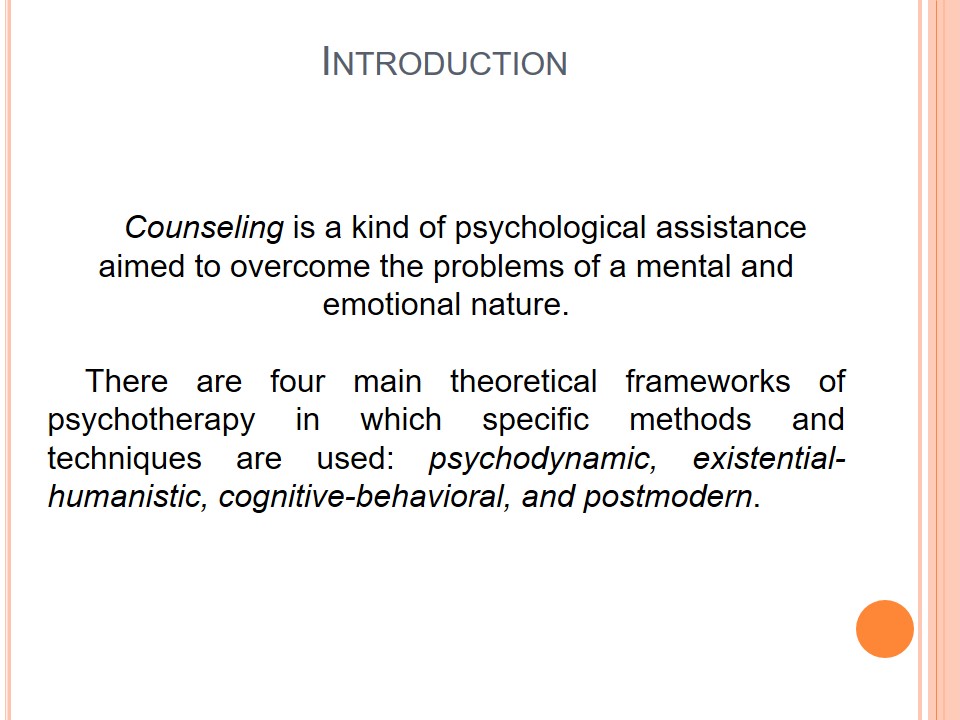
Psychodynamic framework
The term “psychodynamic” or “dynamic” involves the consideration of a person’s mental life in terms of constant dynamics, movement, struggle, conflicts in the psyche, and their influence on the individual.
Models of Human Mind:
- Topographical model:
- Conscious;
- Pre-conscious;
- Unconscious.
- Structural model:
- Id;
- Ego;
- Superego.
Psychodynamic therapy is aimed at the cause of the disease condition, in most cases – neurotic conflict. Its resolution marks the reunification of the unconscious part of the psyche with conscious processes.
The psychodynamic direction comes from old and famous psychoanalysis, the founder of which is Sigmund Freud (Holden, Fall, and Marquis 2017). For psychodynamic direction, it is fundamental that thoughts, feelings, and behavior are deterministic by unconscious mental processes. There are many different schools within the dynamic framework, but perceptions of unconscious mental processes and psychotherapeutic methods are common to members of this approach. The basic concepts studied within the framework of psychoanalysis are the structure of the person’s personality, the stages of personal development, the mechanisms of psychological protection.
According to classical psychoanalysis, there are topographical and structural models of the human psyche (Holden, Fall, and Marquis 2017). For the topographical model, the mind consists of such components:
- conscious – something that person currently realize – is the smallest part of a person’s psyche;
- pre-conscious is something that a person did not currently realize, but it can easily do it;
- unconscious – something that person did not realize – is the most significant part of a person’s psyche.
The unconscious includes primitive instincts, emotions, and memories that are so traumatic to consciousness that they are pushed into the unconscious. For example, child trauma, suppressed sexual desires, hidden hostile feelings towards parents, and others. These unconscious experiences find no way out in ordinary life but manifest themselves in painful symptoms symbolizing the problem (Holden, Fall, and Marquis 2017). The purpose of psychotherapy is primarily their awareness and elaboration.
The structural model of psyche also implies the existence of three main components:
- “ID” is an unconscious structure, which includes innate instincts – the oldest and most stable structure of the mind.
- “Ego” is a conscious structure, a reasonable, rational part of a person. It seeks to fulfill the wishes of “id” following the restrictions adopted in the real world.
- “Superego” is a conscious structure that counteracts and seeks to suppress “id.” It is a unique version of social norms and standards of behavior accepted by an individual. “Superego” develops in the process of upbringing, includes all those values that are formed following social norms. Moreover, it implies a strict system of restrictions, prohibitions, standards.
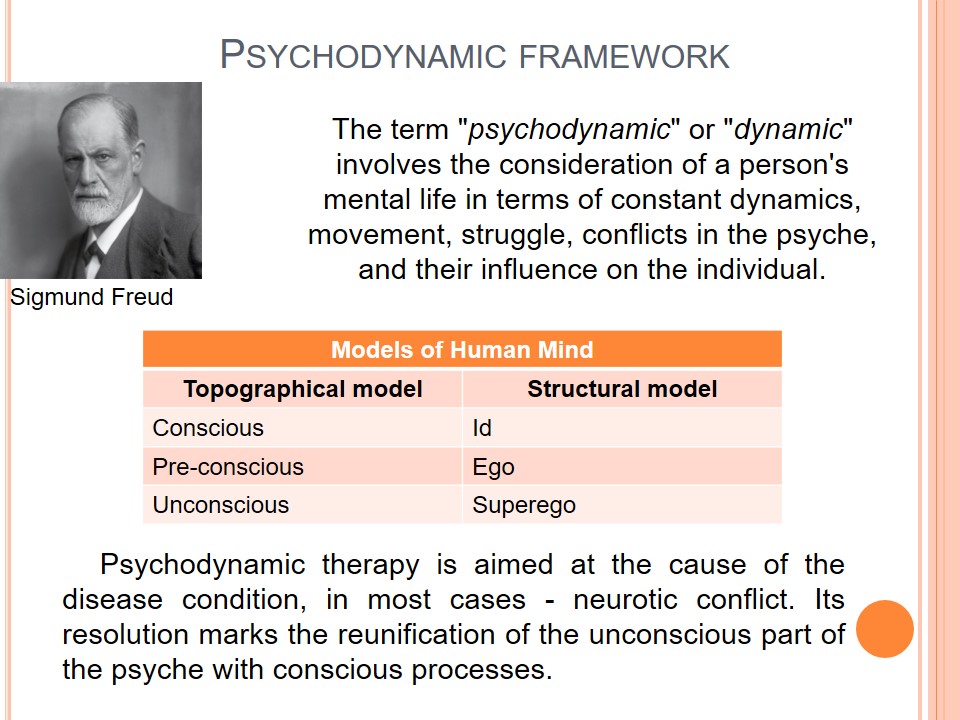
Existential-humanistic framework
Existential-humanistic psychology views personality as a unique, holistic system, that is impossible to understand through individual manifestations and components.
The basic principles of humanistic psychology are: recognition of the holistic nature of human nature, openness to new experience, freedom of will, spontaneity and creative capabilities of man, ability to grow.
The humanist approach does not view anxiety as a negative factor. From this position, stress is constructive, contributing to personal change and development.
This direction is based on the philosophy of European existentialism and the phenomenological approach (Jones-Smith 2019). The main motives driving personal development are the realization of individual capabilities, the desire for self-realization and growth, self-expression, and others. It is happening through the achievement of life goals, and the disclosure of the meaning of their own existence.
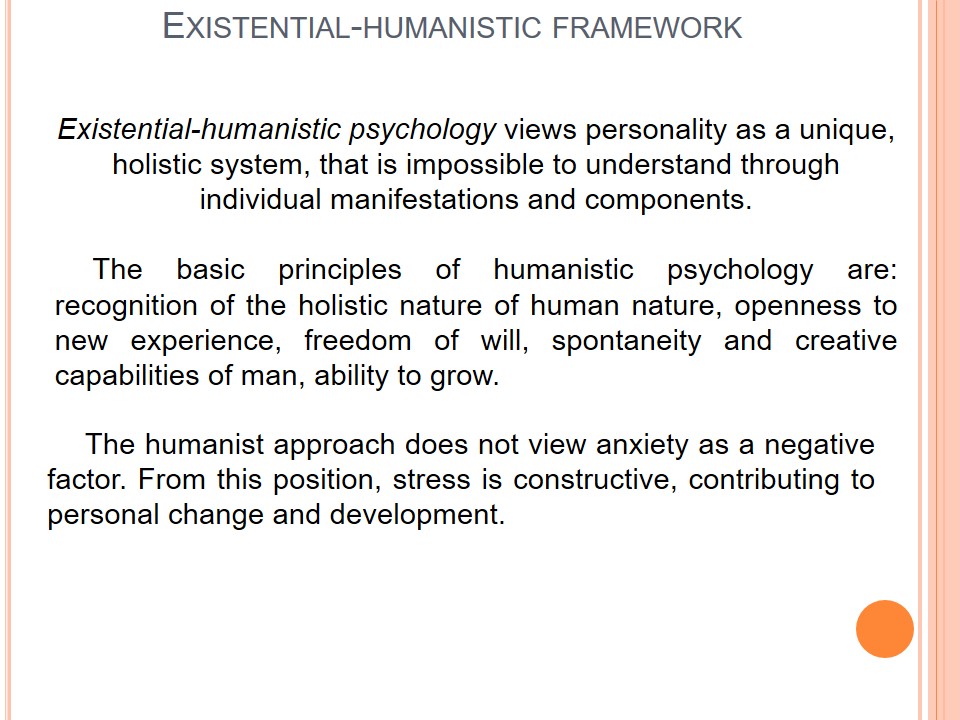
Cognitive-behavioral framework
The cognitive-behavioral approach is focused on changing beliefs, attitudes, thinking patterns, and behaviors.
The theoretical basis of cognitive-behavioral psychotherapy is behaviorism. It is based on the position that science should describe only the phenomena available to direct observation, that is, behavior (Ginter, Gerstein, and Roysircar 2018).
Non-adaptive thinking → Misinterpretation and maladjustment → Disorders
Behavior is a set of reactions of the body to the effects of the external environment, to the particular stimulus. The person is considered as a carrier of certain forms of behavior.
In this direction, professionals are using the principles of teaching. Cognitive-behavioral psychotherapy includes a wide range of methods – cognitive, behavioral, rational psychotherapy, neurolinguistic programming and many others.
In terms of therapy in this direction, non-adaptive thinking is the main reason for psychogenic disorders (Ginter, Gerstein, and Roysircar 2018). Personality is shaping by cognitive structures, which are basal, often unconscious, beliefs (concepts about self, surroundings, and others). Thanks to such expectations, people selectively perceive and assess what is happening. It can lead to misinterpretation and subsequent maladjustment, which will enhance primary belief, by the principle of pathological feedback. Therefore, patient’s problems are in the present, in the real ways of thinking, but not in the past. Thus, the goals of cognitive-behavioral therapy are: correcting the erroneous processing of information and helping patients modify beliefs that support non-adaptive behavior and emotional response.

Postmodern framework
Postmodernists question all theories and assumptions of those frameworks, as they are sure it is impossible to give full answers to all questions (Jones-Smith 2019). Moreover, postmodern counsels move away from the classical focus on the individual and his inner world and view the person as an object formed by a specific environment.
The postmodern approach is significantly different from all previously mentioned. Since postmodernists are skeptical of therapy theories, they do not try to act as authorities during counseling. Instead, they are looking for ways to help without offering specific advice. Thus, this approach favors the use of many different methodologies instead of one.
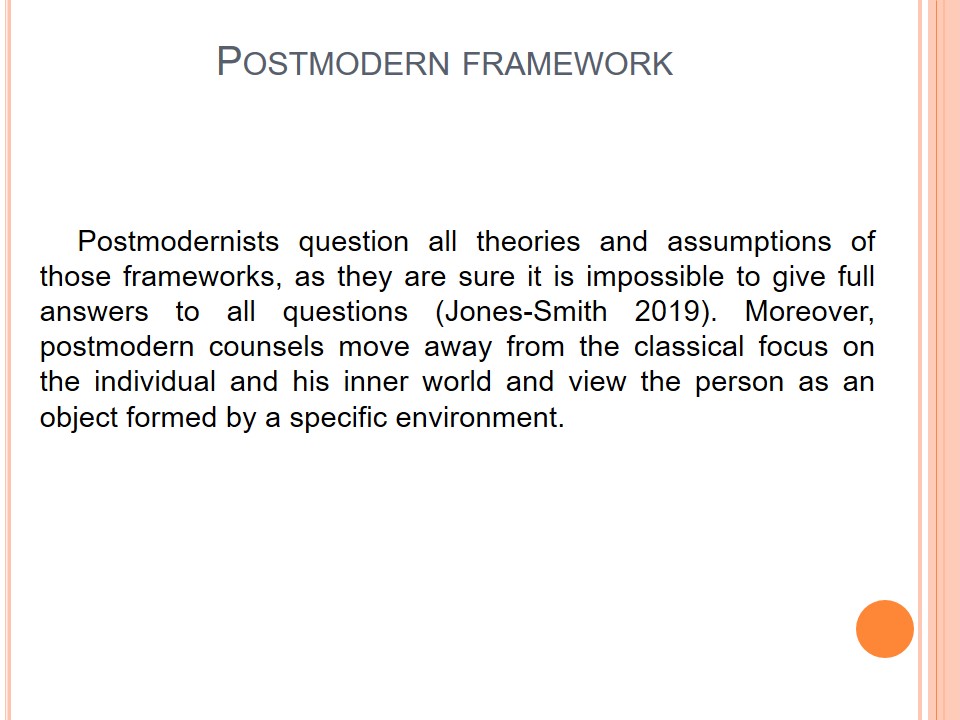
Psychodynamic Theories
- Theory of Object Relations:
- Events of early childhood are tightly woven into the unconscious part of the person’s brain and manifest in social interaction in future adult life.
- Self Psychology:
- In a healthy atmosphere, children develop empathy abilities, as well as self-regulation and self-confidence patterns that will be inherent in adulthood.
Basing on the theory of object relations, the individual’s character and behavior can be explained by the experience he/she gained as a child. For example, if parents behave patiently and warmly with a child, he/she will also treat the world in this way. In the different situation, if parents are cruel – the same will be with the child in adult life.
Within Self Psychology, childhood also plays a main role in the personal development. At the beginning of their life, children will rely on self-objects to help meet needs. However, in the future, such external objects should not be needed under the condition of normally formed regulation and self-confidence patterns.
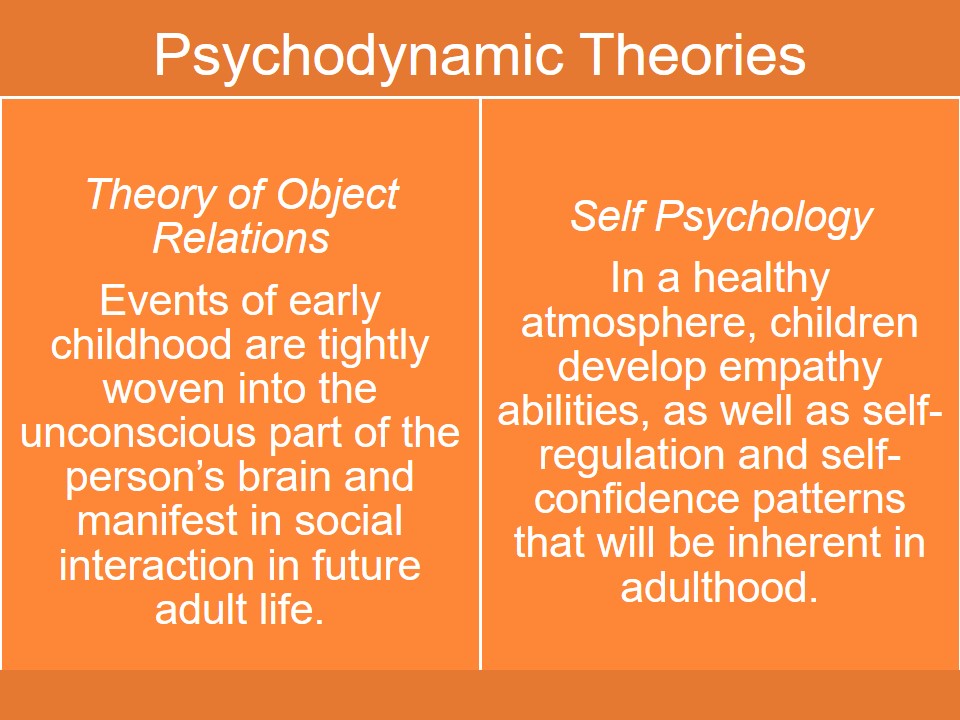
Psychodynamic Counseling Methods
- Free associations. In the process of psychotherapy, the patient lies on the couch, closing his/her eyes, freely associates. It entail other assosiations that lie more deeply in the unconscious. Doctors interpret received associations, pushing the patient to realize the problem.
- Dream analysis. According to the psychoanalytic concept of dreams, they are an attempt to discharge the emotional pressure accumulated during the day. The main task in the study of dreams is to achieve their hidden meaning.
The primary method in dream analysis is again free associations. When working with a patient, it is necessary not to pay attention to the external content of dreams, as it does not correspond in any way to the unconscious studied. Dreams should be broken down into elements, each of which is examined separately.
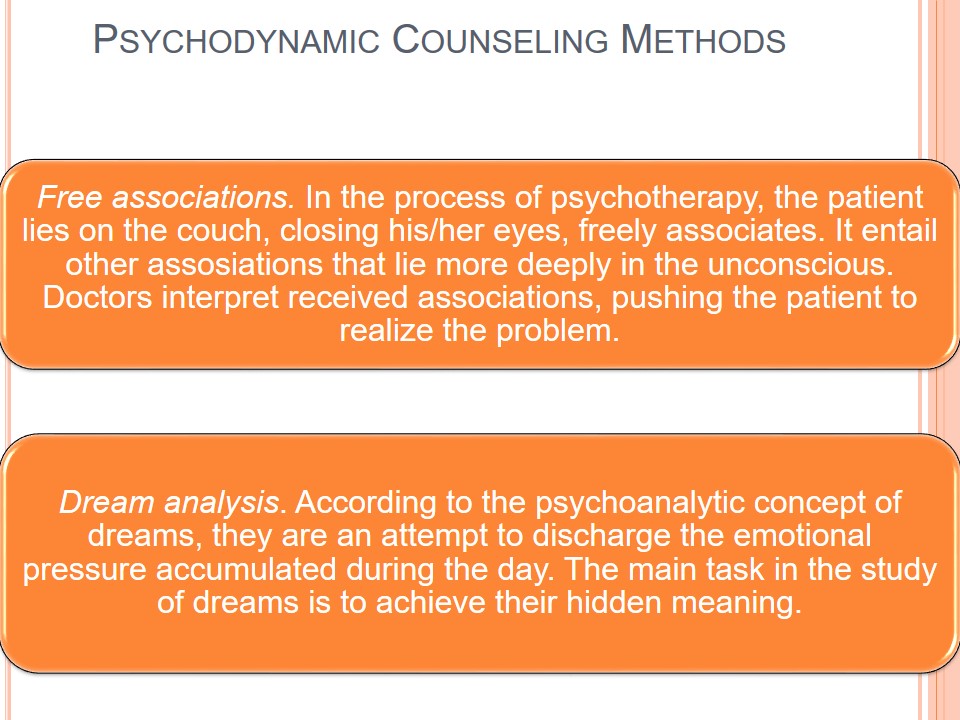
Existential-humanistic theories and concepts
Self-actualization is a process of revealing and implementation all person’s abilities and capabilities.
Gestalt psychology
The human aspires to integrity – perceives the environment not as a set of sensations, but as holistic images. Perception is shaping to focus primarily on the most urgent need.
Reason of mental disorders: the mismatch between a person’s desires and real life.
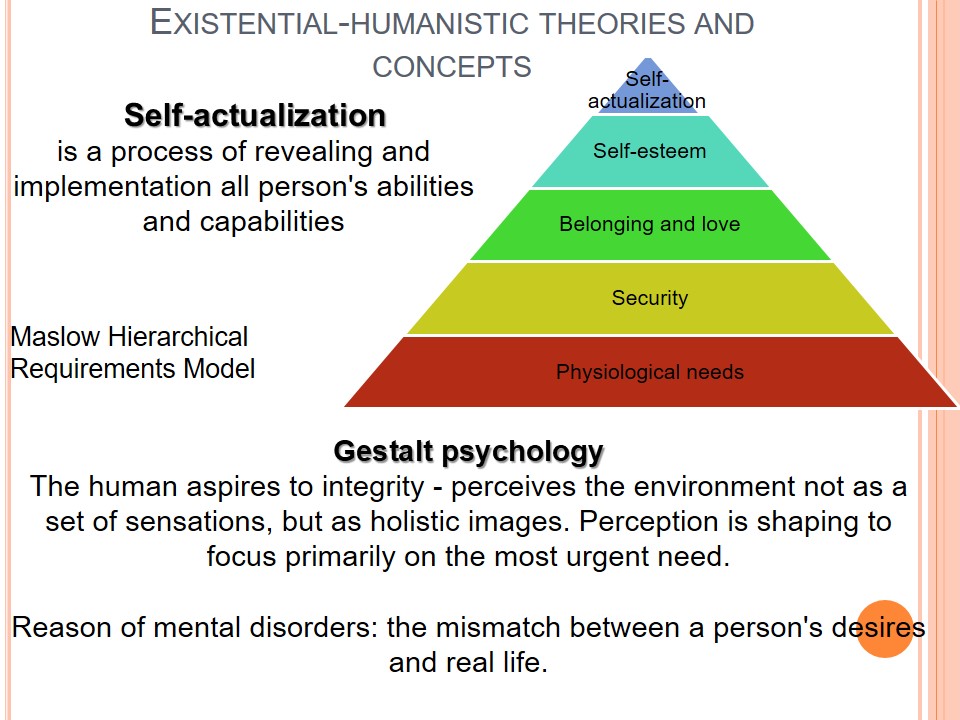
Existential-humanistic methods
The empty chair
An empty chair is placing opposite the chair where the patient sits. He or she is playing a role – talk to an important person as if this man was sitting on an empty chair.
“Here-and-now”
One of the main principles in gestalt therapy is the idea of “here-and-now,” – concentration on the present time. The therapist often asks the patient to determine what he/she currently thinks or feels, what is happening to the person at the moment.
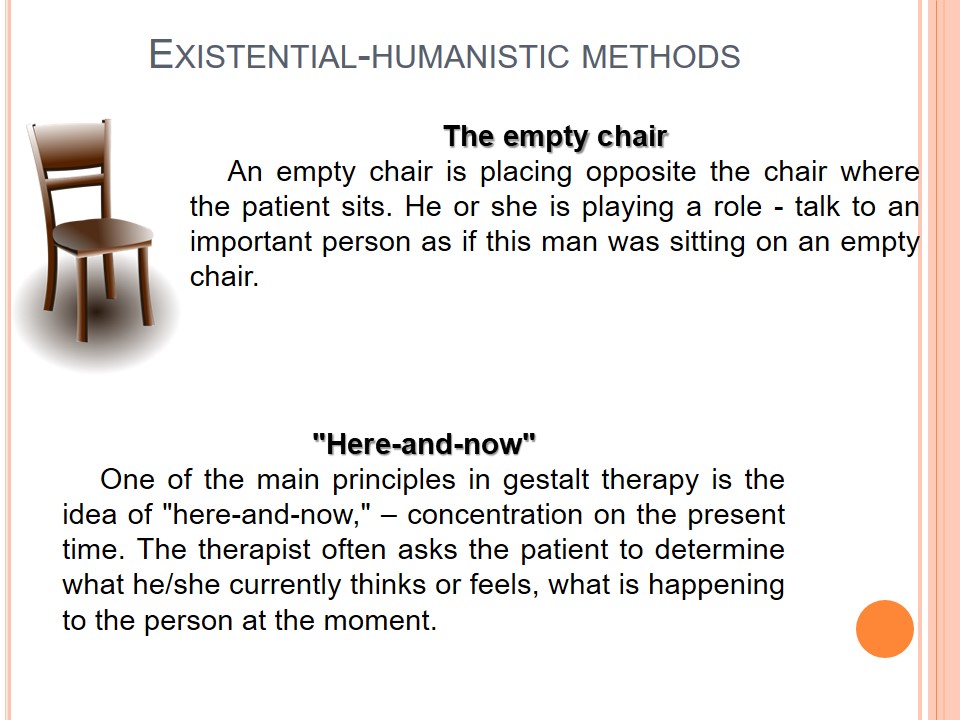
Cognitive-behavioral approaches
- Rational emotional behavior therapy or brief REBT is a type of psychotherapy during which patients detect thoughts, feelings that harm their mental health.
- Dialectical behavior therapy or DBT is designed to treat multiple disorders or a problem that cannot be treated by other methods.
Then the task of rational emotional behavior therapy is to persuade the patient in the irrationality of negative opinions (Holden, Fall, and Marquis 2017). Afterward, the doctor helps replace them with more positive ideas that have a good impact on health.
There are versions of DBT applicable in a variety of care formats, including outpatient and inpatient care, group and individual therapy. It is used in the treatment of a tendency to suicide, deep depression or borderline personality disorder (Ginter, Gerstein, and Roysircar 2018). One of the goals of such therapy is to balance the patient’s acceptance of self and help him/her achieve change.
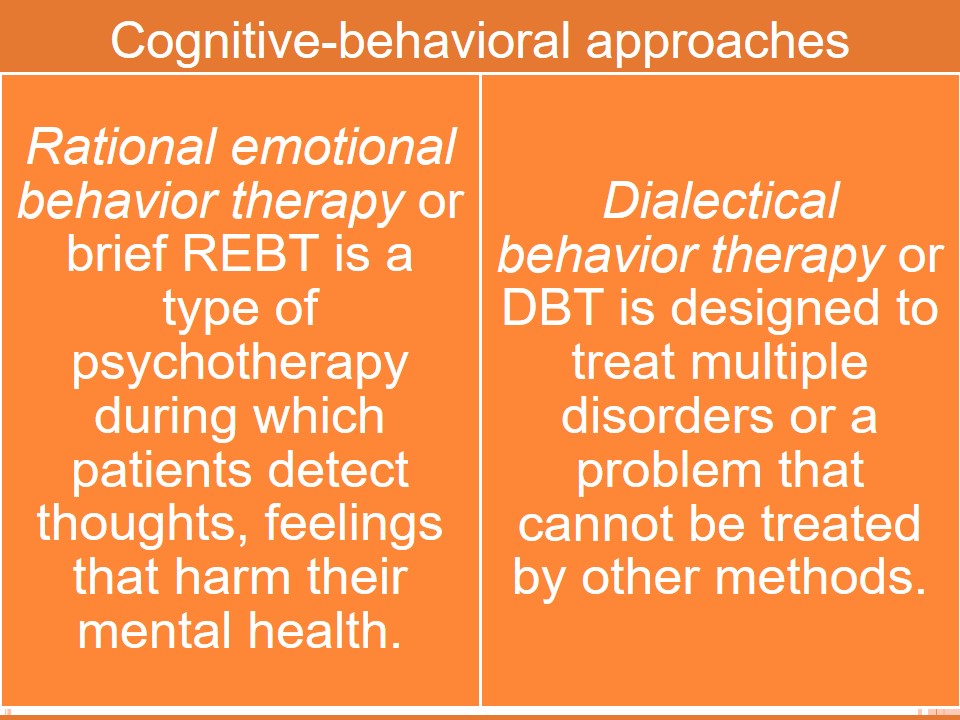
Cognitive-behavioral techniques
Mindfulness – a method is to free patients from the tendency to automatically react negatively to thoughts, emotions, events of life.
Journal writing therapy – the person focus on the main, fights with the complexes, remove stress.
One of the main techniques when applying cognitive-behavioral therapy is mindfulness. By practicing mindfulness, patients try to realize their psychological and physical condition without prejudice.
Another method doctors use within this approach is journal writing therapy. Describing the event, the person contemplates it, learns to focus on the main, fights with the complexes. Moreover, journaling helps to remove stress, which is often the cause of many serious diseases.
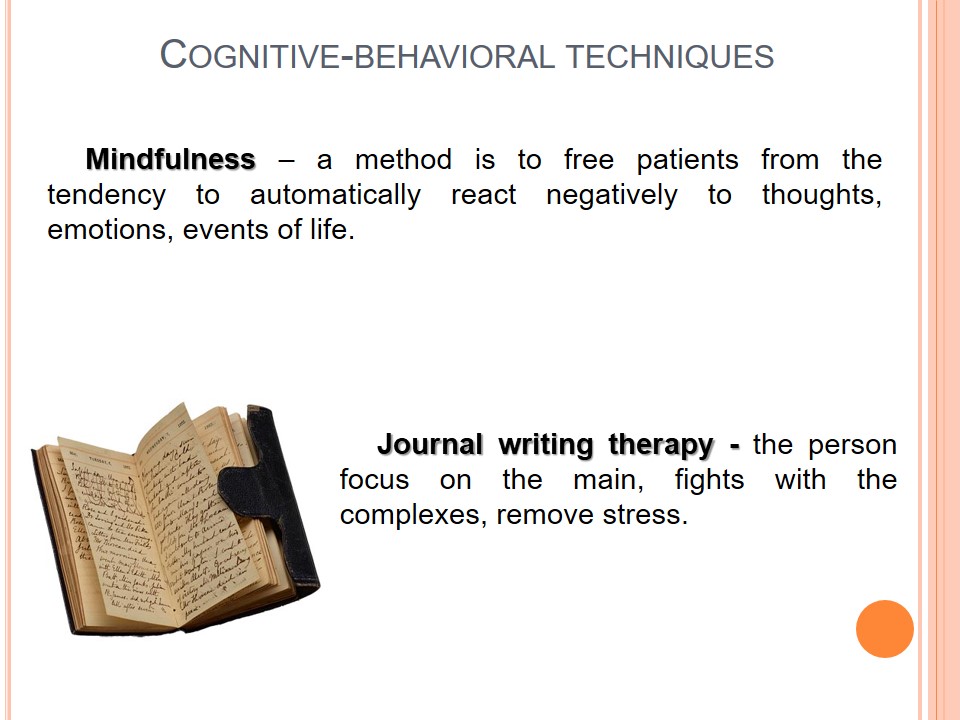
Postmodern approach
During counseling, the doctor helps draw up some narrative structure based on the individual patient’s experience (Jones-Smith 2019). It is the basis of treatment, during which the patient can consider his/her experience from the other side and, directed by the advisor, will learn to manage personal life.
Since the Postmodern calls into question the universality of understanding the person’s mental state and is skeptical of therapeutic theories, a different approach to clients has been developed here.

Postmodern techniques
- During narrative therapy the counselor teaches people that they know their lives better than anyone else and only direct them.
- Solution-Focused therapy is based on search and creating solutions rather than analyzing and finding the causes of problems.
Narrative therapy is a type of psychotherapy that comes from a respectful perspective that does not blame or impose on a person (Jones-Smith 2019). The person who seeks help is not patient or client, as in other therapeutic approaches, but a co-author of the therapy.
During Solution-Focused therapy the main attention is on decisions, hopes, resources, and strengths. To solve the problem, it is not necessary to spend a long time studying the reasons of its occurrence. This type of therapy is practical, useful, and offers hope for change, regardless of the degree of difficulty or expression of problems.
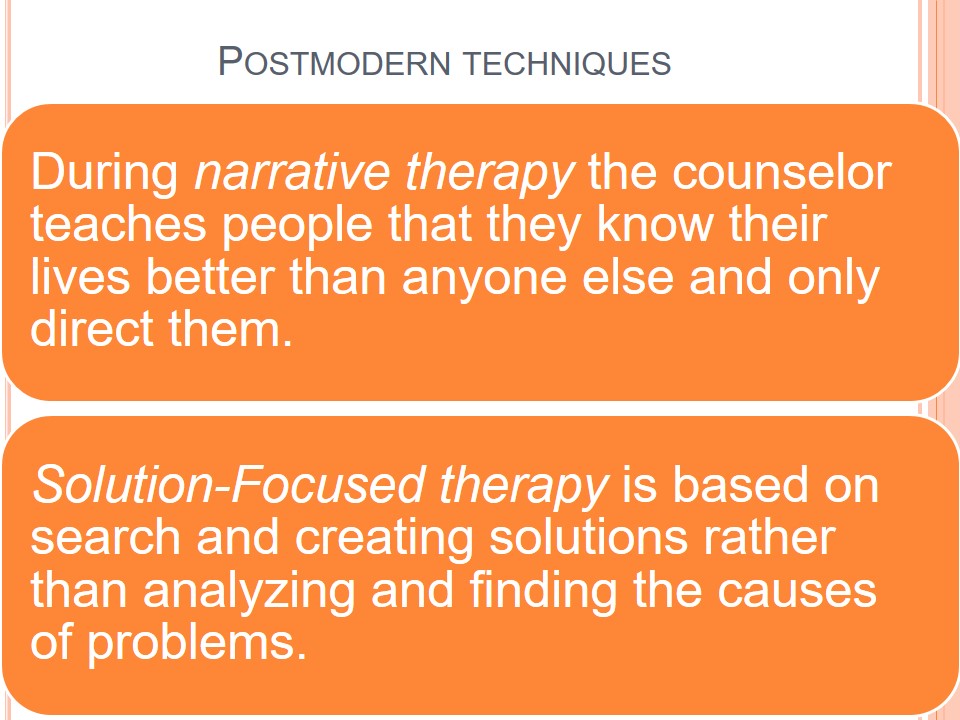
Conclusion
Psychotherapy is developing intensively, finding new and new applications – both in medicine and beyond. Counseling addresses a wide range of challenges, from simply eliminating symptoms and improving quality of life to profound personal changes.
The fact of the ever-increasing need in the therapy of millions of people is undeniable. The reason for this is the modern pace of life when people are increasingly prone to stress, closure, and loneliness. However, the awareness and expression of one’s own feelings and related needs, with the support of a psychotherapist, gradually change the client’s subjective reality.
Counseling is necessary in the contemporary world and will develop, considering various world trends.
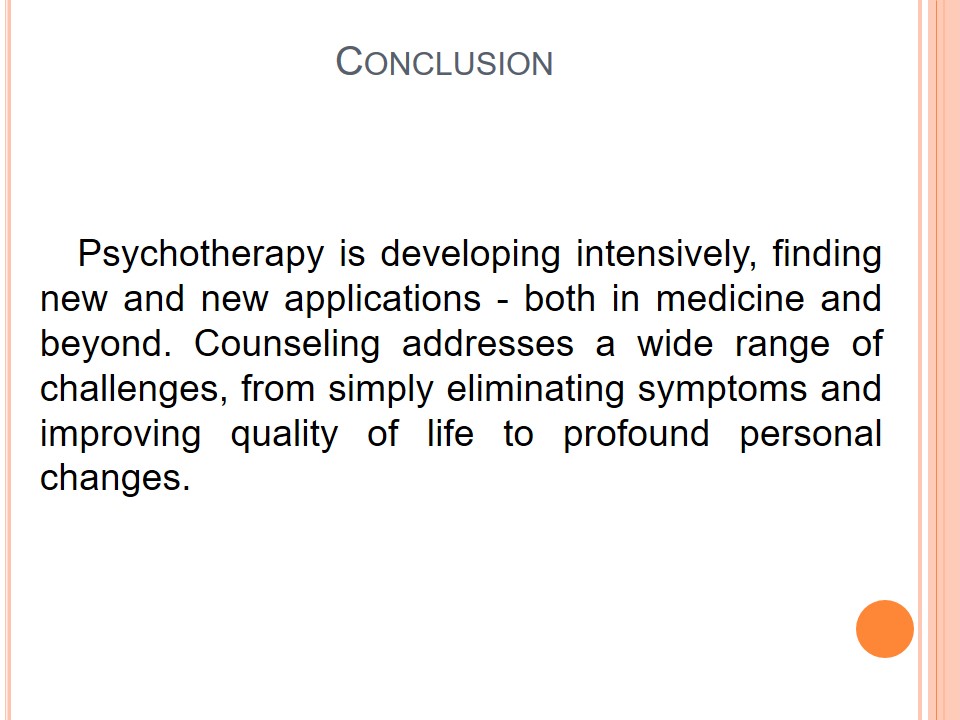
References
Ginter, Dr. Earl J., Lawrence H. Gerstein, and Gargi Roysircar. 2018. Theories and Applications of Counseling and Psychotherapy: Relevance Across Cultures and Settings. Newbury Park: SAGE Publications.
Holden, Janice Miner., Kevin A. Fall, and Andre Marquis. 2017. Theoretical Models of Counseling and Psychotherapy. 3rd ed. London: Taylor & Francis.
Jones-Smith, Dr. Elsie. 2019. Theories of Counseling and Psychotherapy: An Integrative Approach. Newbury Park: SAGE Publications.